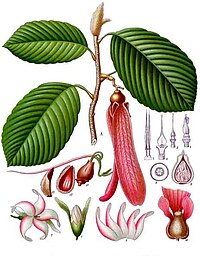
Photo from wikipedia
The role that mycorrhizal fungal associations play in the assembly of long-lived tree communities is poorly understood, especially in tropical forests, which have the highest tree diversity of any ecosystem.… Click to show full abstract
The role that mycorrhizal fungal associations play in the assembly of long-lived tree communities is poorly understood, especially in tropical forests, which have the highest tree diversity of any ecosystem. The lowland tropical rain forests of Southeast Asia are characterized by high levels of species richness within the family Dipterocarpaceae, the entirety of which has been shown to form obligate ectomycorrhizal (ECM) fungal associations. Differences in ECM assembly between co-occurring species of dipterocarp have been suggested, but never tested in adult trees, as a mechanism for maintaining the coexistence of closely related tree species in this family. Testing this hypothesis has proven difficult because the assembly of both dipterocarps and their ECM associates co-varies with the same edaphic variables. In this study, we used high-throughput DNA sequencing of soils and Sanger sequencing of root tips to evaluate how ECM fungi were structured within and across a clay–sand soil nutrient ecotone in a mixed-dipterocarp rain forest in Malaysian Borneo. We compared assembly patterns of ECM fungi in bulk soil to ECM root tips collected from three ecologically distinct species of dipterocarp. This design allowed us to test whether ECM fungi are more strongly structured by soil type or host specificity. As with previous studies of ECM fungi on this plot, we observed that clay vs. sand soil type strongly structured both the bulk soil and root tip ECM fungal communities. However, we also observed significantly different ECM communities associated with two of the three dipterocarp species evaluated on this plot. These results suggest that ECM fungal assembly on these species is shaped by a combination of biotic and abiotic factors, and that the soil edaphic niche occupied by different dipterocarp species may be mediated by distinct ECM fungal assemblages.
Journal Title: Frontiers in Plant Science
Year Published: 2017
Link to full text (if available)
Share on Social Media: Sign Up to like & get
recommendations!